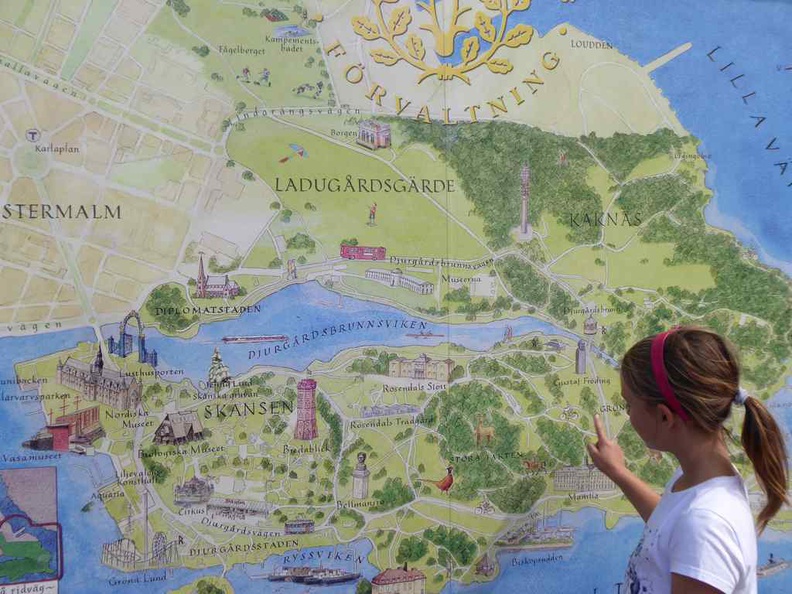The Vasa was a majestic European sail battleship. It is the highlight and focal point of the Vasa Museum located on the Stockholm Djurgården museum island. You might remember our last visit there when we checked out the Skansen open-air museum.

In a nutshell, the mighty Vasa warship was an ancient cannon battleship. Possibly the world’s best preserved 17th-century battleship, salvaged from the seabed after it tragically sank after capsizing in Stockholm on 1628.

Moreover, the Stockhom museum island is a family-focused one. It has many large open parks, spaces, cafes great for a family and kids day out.
Also, the Swedish are very fond of their maritime history, as like the Vikings as conquerors in the early ages. Going on the maritime theme, there are several other notable marine mini exhibits you can find here.
A cavernous enclosure of the museum
Moreover, entry to the Stockholm Vasa Museum costs SEK 170 for adults, with free entry for under 18. Also, I would recommend going in the morning with smaller crowds and queues, and to enjoy the museum without much distractions.

Furthermore, the maritime museum is a large and cavernous one. Also, the museum building completely encases the entire Vasa ship indoors in a dimly-lit climate controlled environment. I can guess this is to ensure that the historical artifact is well-preserved and protected from future degradation.
A flagship of bad design
Upon completion, the Vasa was one of the most powerfully armed vessels in the world. She has 5 decks with 4 decks under the main deck, comprising of gun, storage and crew decks. Also the ship was crowning glory of the Swedish navy, much to its rich decoration as a symbol of the king’s ambitions for Sweden and himself.

The sinking of the Vasa was much an embarrassment as she was not lost during battle, but rather an accident due to bad design. This was due to bad hull design, where too much of the ship sits above the waterline. Hence, she was dangerously unstable, with too much weight in the upper structure of the hull.

History has it that the Vasa sank as it had very little initial stability. A strong wind gust during her maiden voyage out of the Stockholm harbour on 1628 forced the ship onto her port side. This pushed her open lower gun-ports under the water surface.
It was unrecoverable as she started taking in water onto the lower gundeck, quickly exceeding the ship’s minimal ability to right itself. Water kept continuing to pour in until it ran down into the hold.
A well-preserved piece of history
Since the accident, the Vasa lay rested for over three centuries. A total of 333 years in fact on the sea bed near the Stockholm harbour. Also, she was located again in the late 1950s after a search, discovered on the inlet of a busy shipping area in Stockholm harbour. Moving on, on 1961, the feat to raise, salvage and restore her largely intact hull from the seabed started.
Notably, almost all of the iron on the ship rusted away within a few years of the sinking and she was filled with seabed marine mud. But much of the ship and wood remains largely intact. Also, large objects, such as anchors, or items made of cast iron, such as cannonballs, survived.
Additionally, the near-intact resurrection of the Vasa, with plenty of her artifacts and the ship herself intact was much to the delight of historians. Also. it provided invaluable insights, allowing a peek into the early way of life of the early Swedish maritime life. Going into details of naval warfare, shipbuilding techniques and everyday life in early 17th-century Sweden.
Exploring the museum and micro-exhibits

Moreover, here, a combination of elevators and nicely placed stairs served various vantage and viewing points though out the building. Also, exhibits ranges from viewing decks to micro-exhibits with mock-ups of under deck rooms and enclosures.
This is done through a mix of scale models, behind glass displays and showing the way on life on-board the ship then.

Additionally covered are also extracts of the Swedish fleets, marine formations, craftsmanship to the way of life below the decks. Also, the ship is large and menacing in person, especially up close. Also, her sides are lined with rows of opened canon doors revealing a battle arsenal seen in flagships during its time.

Notably, despite the large number (and weight) of bronze cannons, the ship’s instability was not due to the high placement of the canons, which took up 5% of the entire ship displacement. Interestingly, these canons were forged and casted in Stockholm specifically for the Vasa.
Moreover, organic materials fared better in the undersea anaerobic conditions, including wood, cloth and leather. Also, these were extracted in very good condition. Additional items savaged includes weapons, cannons, tools, coins, cutlery, food, drink and six of the ten of the ship’s sails.
All in all, despite its embarrassing history, the Stockholm Vasa Museum is a must-visit for its historical significance and one of the best preserved pieces of 17th century maritime history. Great for a half day out exploring the random ship musing on Stockholm museum island, or maybe a game of Segway polo?



























[…] also home to a number of world-class museums and a museum island. The museum island is home to the Vasa museum and Skansen open-air museum, with each in their own right takes almost an entire day […]